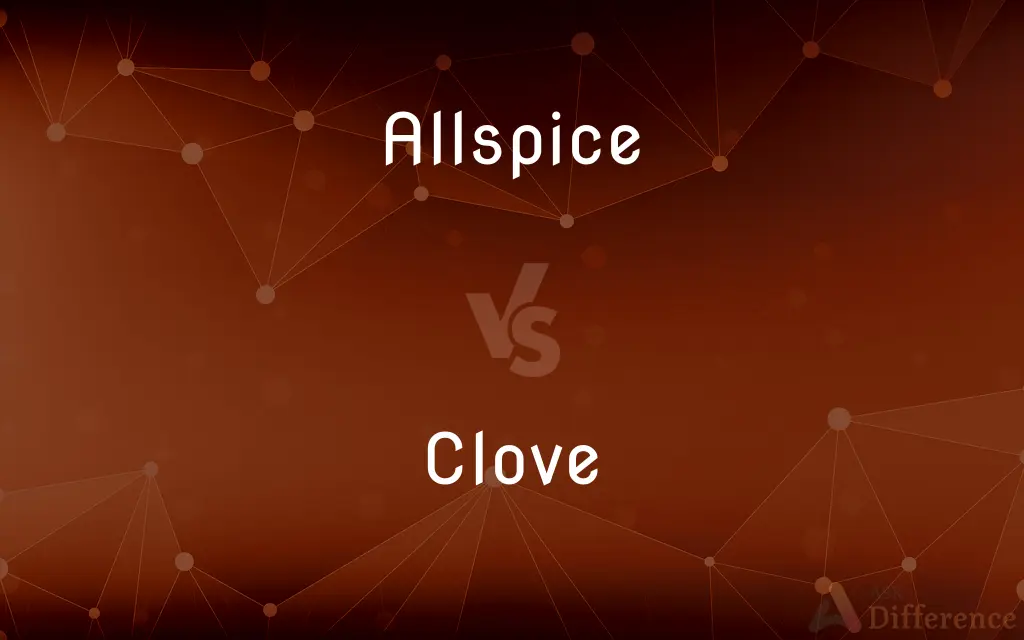Allspice vs. Clove — What's the Difference?
Edited by Tayyaba Rehman — By Fiza Rafique — Updated on October 29, 2023
Allspice is a spice made from dried pimento berries, resembling a mix of cinnamon, nutmeg, and cloves, while Clove is a spice from dried flower buds of a specific tree, having a strong, pungent flavor.

Difference Between Allspice and Clove
Table of Contents
ADVERTISEMENT
Key Differences
Allspice, derived from the dried berries of the Pimenta dioica tree, is native to the West Indies and Central America. It's often described as having a taste that's a blend of multiple spices, namely cinnamon, nutmeg, and cloves. Its name, "allspice," reflects this amalgamation of flavors. On the other hand, Clove is derived from the dried flower buds of the Syzygium aromaticum tree, native to the Maluku Islands in Indonesia. Its flavor is distinctive, strong, and quite pungent.
Despite its name suggesting a blend, Allspice is a unique spice and not a mixture of several spices. When crushed or ground, it releases its signature flavor, reminiscent of several beloved spices, making it a versatile ingredient in both savory and sweet dishes. In contrast, Clove has a very dominant flavor, making it essential to use it sparingly in dishes to prevent overpowering other flavors.
Both Allspice and Clove are common in various cuisines around the world. In the culinary arts, allspice is prevalent in Caribbean, Middle Eastern, and Latin American cuisines, often in jerk seasonings and marinades. Simultaneously, Clove is integral to various Asian, African, and Middle Eastern dishes, not just for its flavor but also for its medicinal properties.
The uses of Allspice and Clove aren't restricted to the culinary world. Both spices have been utilized for their medicinal benefits. Allspice can help with digestive issues and has anti-inflammatory properties. Clove, with its antiseptic properties, is often found in dental products and traditional remedies for toothaches.
From a culinary perspective, while Allspice offers a milder, blended flavor suitable for a range of dishes, Clove delivers a potent kick that can define a dish. However, regardless of their differences, both spices contribute richly to the global tapestry of flavors.
ADVERTISEMENT
Comparison Chart
Origin
Dried berries of the Pimenta dioica tree
Dried flower buds of the Syzygium aromaticum tree
Native Region
West Indies and Central America
Maluku Islands in Indonesia
Flavor Profile
Blend of cinnamon, nutmeg, and cloves
Strong, pungent, and distinctive
Common Usage
Caribbean, Middle Eastern, Latin American cuisines
Asian, African, and Middle Eastern cuisines
Medicinal Benefits
Digestive aid, anti-inflammatory
Antiseptic, used for dental issues
Compare with Definitions
Allspice
Beneficial for digestive issues.
Drinking allspice tea can soothe an upset stomach.
Clove
A spice from dried flower buds.
She sprinkled some clove powder into the mulled wine.
Allspice
Often used in sweet and savory dishes.
The allspice added depth to the stew's flavor profile.
Clove
Strong, pungent, and distinctive in flavor.
The clove's aroma immediately filled the room.
Allspice
Common in Caribbean cuisine.
Jerk chicken uses allspice as a primary ingredient.
Clove
Known for its antiseptic properties.
Clove oil helped alleviate his toothache.
Allspice
A spice from dried pimento berries.
She added allspice to the pie for a warm flavor.
Clove
Integral to some traditional remedies.
She prepared a clove tea for its health benefits.
Allspice
Allspice, also known as Jamaica pepper, myrtle pepper, pimenta, or pimento, is the dried unripe berry of Pimenta dioica, a midcanopy tree native to the Greater Antilles, southern Mexico, and Central America, now cultivated in many warm parts of the world. The name "allspice" was coined as early as 1621 by the English, who valued it as a spice that combined the flavours of cinnamon, nutmeg, and clove.Several unrelated fragrant shrubs are called "Carolina allspice" (Calycanthus floridus), "Japanese allspice" (Chimonanthus praecox), or "wild allspice" (Lindera benzoin).
Clove
Cloves are the aromatic flower buds of a tree in the family Myrtaceae, Syzygium aromaticum. They are native to the Maluku Islands (or Moluccas) in Indonesia, and are commonly used as a spice.
Allspice
An evergreen tree (Pimenta dioica) native to the West Indies, Mexico, and Central America, having opposite, simple leaves and white flowers clustered in cymes.
Clove
An evergreen tree (Syzygium aromaticum) native to the Moluccas and widely cultivated as a source of oil and for its aromatic dried flower buds.
Allspice
The dried, nearly ripe berries of this plant, used as a spice. In both senses also called pimento.
Clove
A flower bud of this plant, used whole or ground as a spice.
Allspice
(uncountable) A spice; the dried and ground unripe fruit of Pimenta dioica, thought to combine the flavours of several spices, such as cinnamon, nutmeg and cloves.
Clove
One of the small sections of a separable bulb, as that of garlic.
Allspice
(countable) Pimenta dioica, an evergreen tree of tropical America with aromatic berries.
Clove
A past tense of cleave1.
Allspice
The berry of the pimento (Eugenia pimenta), a tree of the West Indies; a spice of a mildly pungent taste, and agreeably aromatic; Jamaica pepper; pimento. It has been supposed to combine the flavor of cinnamon, nutmegs, and cloves; and hence the name. The name is also given to other aromatic shrubs; as, the Carolina allspice (Calycanthus floridus); wild allspice (Lindera benzoin), called also spicebush, spicewood, and feverbush.
Clove
(Archaic)A past participle of cleave1.
Allspice
Aromatic West Indian tree that produces allspice berries
Clove
A past tense of cleave2.
Allspice
Deciduous shrubs having aromatic bark; eastern China; southwestern and eastern United States
Clove
A very pungent aromatic spice, the unexpanded flower bud of the clove tree.
Allspice
Ground dried berrylike fruit of a West Indian allspice tree; suggesting combined flavors of cinnamon and nutmeg and cloves
Clove
(countable) A clove tree, of the species Syzygium aromaticum (syn. Caryophyllus aromaticus), native to the Moluccas (Indonesian islands), which produces the spice.
Allspice
Resembles a blend of multiple spices.
Allspice's unique taste is like a mix of several familiar spices.
Clove
(countable) An old English measure of weight, containing 7 pounds (3.2 kg), i.e. half a stone. is this under the correct etymology?
Clove
One of the small bulbs formed in the axils of the scales of a large bulb.
Clove of garlic, garlic clove, clove of a sea-onion, clove of shallot, cloves of bulbs
Clove
Cleft.
Clove
A cleft; a gap; a ravine; - rarely used except as part of a proper name; as, Kaaterskill Clove; Stone Clove.
Clove
A very pungent aromatic spice, the unexpanded flower bud of the clove tree (Eugenia aromatica syn. Caryophullus aromatica), a native of the Molucca Isles.
Clove
One of the small bulbs developed in the axils of the scales of a large bulb, as in the case of garlic.
Developing, in the axils of its skales, new bulbs, of what gardeners call cloves.
Clove
A weight. A clove of cheese is about eight pounds, of wool, about seven pounds.
Clove
Aromatic flower bud of a clove tree; yields a spice
Clove
Moderate sized very symmetrical red-flowered evergreen widely cultivated in the tropics for its flower buds which are source of cloves
Clove
One of the small bulblets that can be split off of the axis of a larger garlic bulb
Clove
Spice from dried unopened flower bud of the clove tree; used whole or ground
Clove
Essential in many Asian dishes.
The rice dish had a hint of clove, giving it a rich taste.
Common Curiosities
Why is clove used in dental products?
Clove has antiseptic properties and can help alleviate toothaches.
Does allspice contain cloves?
No, allspice is its own spice, though its flavor is reminiscent of several spices, including cloves.
Can I use allspice and clove interchangeably in recipes?
While they have similar warmth, they have distinct flavors, so it might alter the dish's taste.
How is clove typically used in cooking?
Clove can be used whole or ground, but due to its strong flavor, it's used sparingly.
How should I store cloves to maintain their flavor?
Store in an airtight container in a cool, dark place.
Where does allspice originate from?
Allspice is native to the West Indies and Central America.
What is the main use of clove in cuisine?
Clove is used in various Asian, African, and Middle Eastern dishes for its strong flavor.
Are there health benefits to consuming allspice?
Yes, allspice can aid digestion and has anti-inflammatory properties.
Can too much clove be overpowering in a dish?
Yes, due to its potent flavor, it's essential to use clove judiciously.
Can I substitute clove for allspice in baking?
While they both add warmth, they have distinct flavors, so the final product will taste different.
Why is allspice called "allspice"?
Its name reflects its flavor, which seems like a blend of multiple spices.
How is allspice typically used in Caribbean cuisine?
It's a primary ingredient in jerk seasonings and various marinades.
Is allspice the same as mixed spice?
No, while allspice is a single spice, mixed spice is a blend of several spices.
Is allspice popular in any beverages?
Yes, it's used in certain warm drinks and also in some alcoholic beverages like rum.
What are the medicinal uses of clove?
Beyond its antiseptic properties, clove has been used for digestive issues and respiratory ailments.
Share Your Discovery

Previous Comparison
Indict vs. Convict
Next Comparison
Milliner vs. HatterAuthor Spotlight
Written by
Fiza RafiqueFiza Rafique is a skilled content writer at AskDifference.com, where she meticulously refines and enhances written pieces. Drawing from her vast editorial expertise, Fiza ensures clarity, accuracy, and precision in every article. Passionate about language, she continually seeks to elevate the quality of content for readers worldwide.
Edited by
Tayyaba RehmanTayyaba Rehman is a distinguished writer, currently serving as a primary contributor to askdifference.com. As a researcher in semantics and etymology, Tayyaba's passion for the complexity of languages and their distinctions has found a perfect home on the platform. Tayyaba delves into the intricacies of language, distinguishing between commonly confused words and phrases, thereby providing clarity for readers worldwide.















































